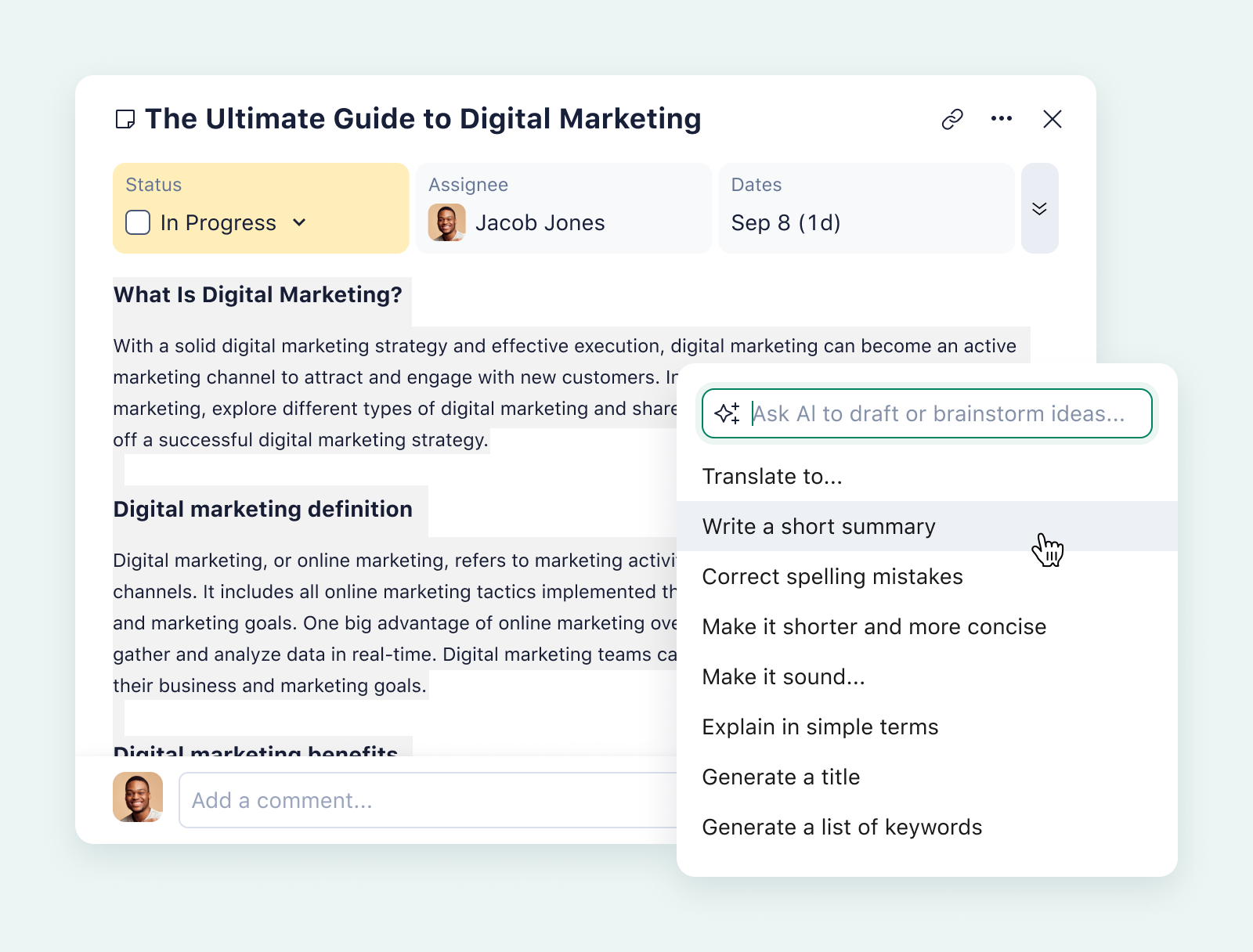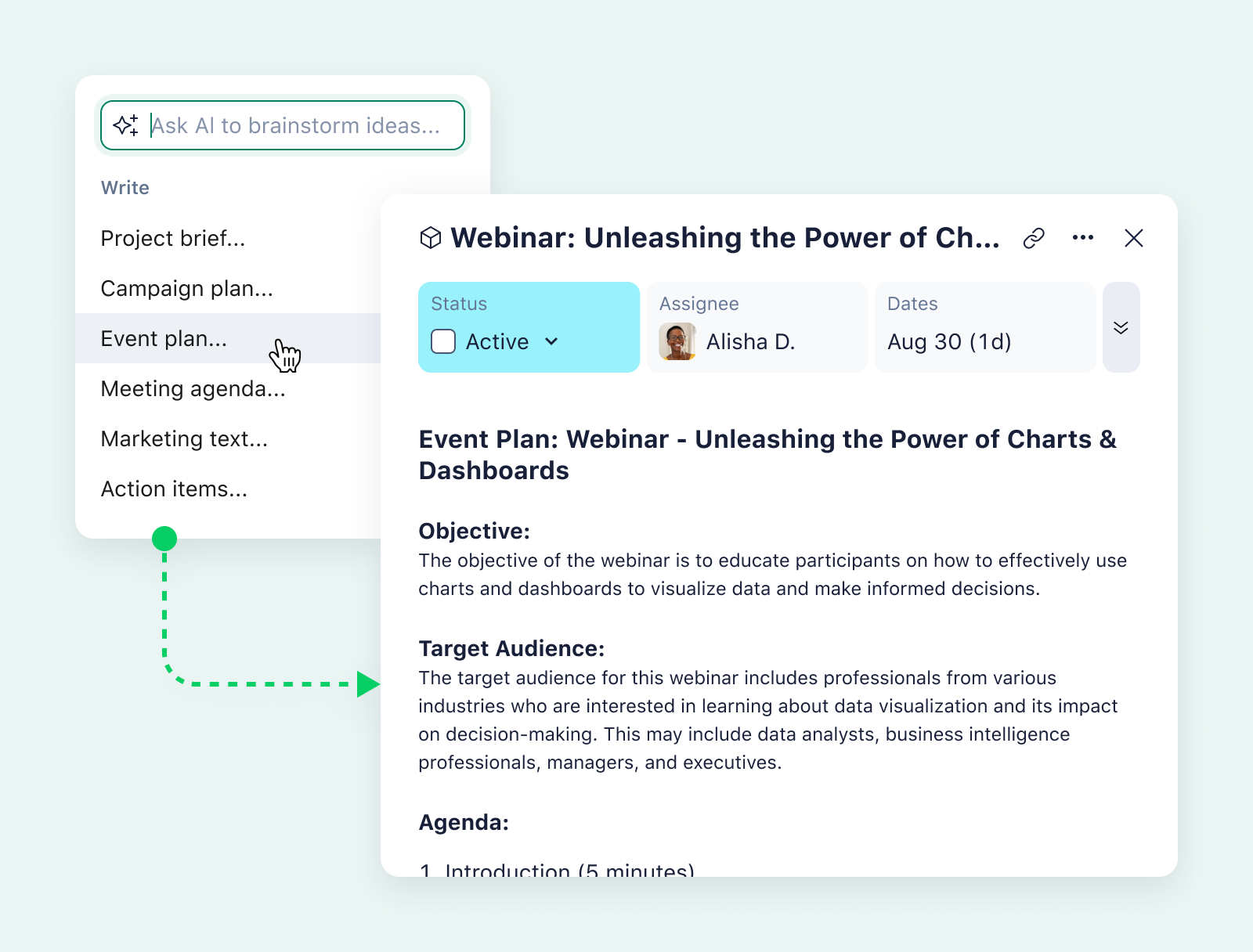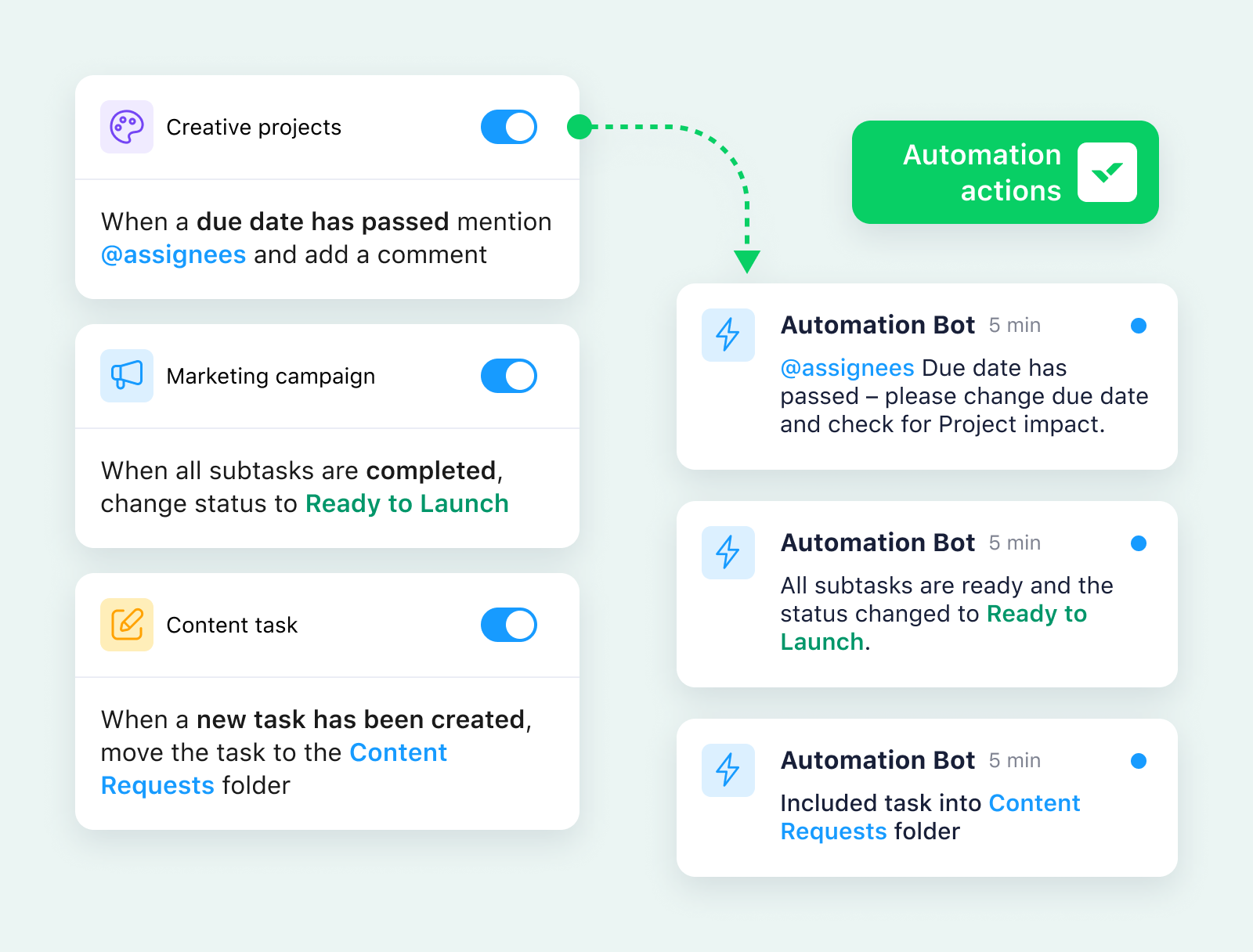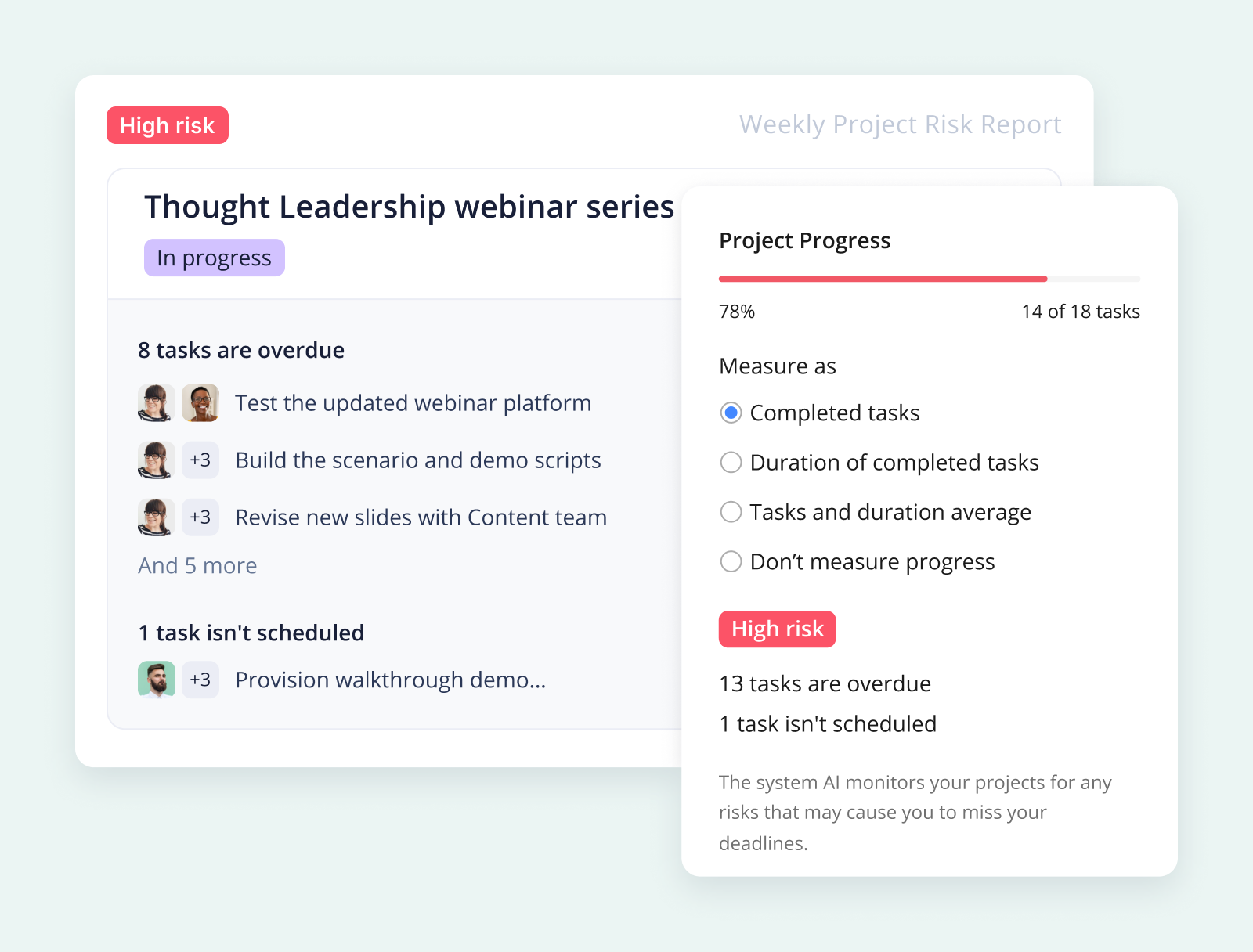I’ll admit that workflow management wasn’t in my lexicon a decade ago. As a freelance writer, I sure could have used an upgrade to my chaotic task management. But after four years working at Wrike, I’m fully converted to the workflow lifestyle.
It’s been fascinating to watch the speed with which Wrike has incorporated AI automation into workflow automation, and it saves me so much time and energy every single day. That’s why I’ll always put up my hand to write about AI automation — and to share how our team and our customers are using Wrike to maximize their workflows.
AI and automation are quickly expanding into every area of our lives, from the AI algorithms that curate your Spotify queue to smart home devices that adjust temperatures and lights for your optimum comfort. Similarly, in the workplace, AI tools are creeping in as well, allowing for things like more seamless meeting scheduling or filtering of emails for spam. But AI automation is also beginning to enhance productivity in project management workflows in really meaningful ways.
In this article, I’ll discuss the nuts and bolts of AI automation, its benefits, and a host of task automation tools. I’ll also include real-life examples of powerful workflow automation from a handful of Wrike customers who shared their secrets for productivity success at our recent work management conference, Collaborate 2024. 
Tales from Collaborate 2024: How Wrike customers increase productivity in their workflows
Learning about AI automation is interesting, but what makes it come to life is learning about how real people use it to impact their own day-to-day workflows. At our recent Collaborate work management conference, I was really excited to hear from so many Wrike customers who are using Wrike’s automation platform to enhance their productivity.
First, Sherrie Besecker at Syneos Health hosted a session called Moving the Mountain: Deploying Wrike at Scale, which you can watch on demand now. She explained to attendees that the healthcare company previously faced chaotic workflows because people used different project management tools, which led to inefficiencies and difficulties in aligning project tasks. The team relied Excel and email when managing projects, but these tools weren’t flexible or adaptable for managing complex tasks.
Once Syneos Health started using Wrike to manage project management workflows, everything changed for the better, with employees relying on Wrike as a single source of truth for all project management information.
Syneos Health teams also rely heavily on the AI features baked into the Wrike platform. Sherrie uses the Wrike magic wand for a range of AI automations to improve her workflow.

It’s a game changer. I call it the twinkle button because that’s how it makes me feel. Whenever I see it, I’m like, let me hit the twinkle button and see what happens.
Sherrie Besecker, Creative Technology Manager

Something that took me 30 seconds, it would have taken me hours to search servers for old documents to refer to … [Wrike’s] helping us work smarter, not harder.
Sherrie Besecker, Creative Technology Manager
Ultimately, Wrike’s AI has been a transformative tool for Syneos Health, enhancing workflow efficiencies and task management.
Aric Pearson, Director of Commerce at West Music Company, also finds the summarizing AI function helpful. His session, Get More Done in Less Time With Wrike’s GenAI and Automation, is also available to watch on demand anytime.
When we do have a lot of back and forth, the AI summaries are really helpful ... you have weeks of communication that you can just summarize in an instant.
Aric Pearson, Director of Commerce, West Music Company
Wrike has also helped West Music Company streamline its intake process with automated request forms.
This used to be a very manual process of getting requests for the marketing or web teams from various stakeholders. And with [Wrike’s request] forms, we make sure we’re getting the information we need every time, which eliminates potentially days or weeks of back and forth just to get off the ground.
Aric Pearson, Director of Commerce, West Music Company

David Alonso at Swinerton Brothers, a national construction company, joined the same session and explained that his team used to struggle with managing various large workflows without automation. Now, they’ve adopted Wrike and rely on Wrike-based workflows they’ve built over time.
We like to utilize our workflow visualization charts in order to be able to map out all of our business processes. That helps us track all of our automation triggers and allows us to create more efficient work processes and business workflows.
David Alonso, Swinerton Brothers
Finally, James Ball, VP of Project Management at marketing agency Jellyfish, joined Collaborate for a session called Scrap the Spreadsheets: Increase Collaboration (available on demand now!). He offered insight into the ways Wrike’s AI automation has enabled his organization to streamline processes, improve communication, reduce email dependency, and enhance task visibility. Unfortunately, the organization found itself relying on disparate tools like spreadsheets for work management, a challenge that was solved by switching to Wrike.
Not only was James able to bring everyone into the same platform to keep everyone on the same page, but the organization has also saved money. He explained, “By removing all of these different platforms that were working in a very siloed approach, we have saved money.”
In addition, James recalled that he was also able to overdeliver for clients who were looking for a summary of a project to share with stakeholders.
I was able to use the AI summary by clicking a button, and it told the story of how it started, what action items came out of it, and some of the key decisions that were made along the way. It summarized that in a beautiful, natural language way that was easy to interpret. It was so powerful to be able to do that.
James Ball, VP of Project Management, Jellyfish
You can watch all of the Collaborate 2024 sessions on demand to catch up on even more stories of customers who are enhancing their productivity with AI automation through Wrike.
How does AI work and what is AI automation?
If you aren’t quite as knowledgeable about AI automation as our Collaborate 2024 speakers are, let’s start with the foundation: what is AI automation? AI automation is the integration of artificial intelligence, or AI, technology into tasks or processes, where machines complete tasks that would otherwise require a human’s effort. Whereas initial AI automation technologies were rather simple and basic, AI automation is becoming increasingly advanced. AI automation can now complete complex processes without human input and is quickly increasing efficiency and accuracy throughout and across industries.
Traditional automation relied on predefined rules to repeat processes, but it wasn’t adaptable. AI automation relies on data, and lots of it, to adapt to changing environments and learn from previous experiences. Through a combination of machine learning (ML), natural language processing (NLP), and computer vision, AI automation can continually improve its performance over time, completing complex processes and improving efficiency in a wide range of settings.
Because AI is so reliant on data to learn how to adjust in various situations, privacy is an ongoing concern. AI systems require large datasets for training, leading to the potential risk of exposing sensitive information. These datasets often contain personal or confidential information that can be vulnerable to unauthorized access or misuse. Data breaches or leaks during the collection, storage, or transfer of these datasets can lead to serious privacy violations and financial repercussions for individuals and organizations alike.
Companies need to contract with reputable businesses for any AI automation products. Here at Wrike, all AI projects undergo threat modeling and security reviews at all stages, from design to implementation. We might use general data, such as anonymized search-related historical usage statistics, for Wrike machine learning model training, but specific data, such as user names and associated task descriptions, is never stored or used for model training.
We also adhere to an AI ethics policy, which outlines how we approach AI guided by our four principles: keeping AI customer-focused, collaborative, creative, and accountable. We recognize the power of AI to transform the workplace, but we also acknowledge the responsibilities that come with this technology. We consistently work to make sure our customers can trust us to secure their data while focusing on innovation that will improve their workflows and productivity.
Is AI automation worth it?
AI automation has overwhelming benefits for workplace efficiency when the risks of ethical and data privacy issues are managed well. By taking over repetitive and time-consuming tasks, AI-powered systems free up human workers to focus on more impactful work and creative endeavors, leading to innovation and growth.
In sectors like healthcare, AI can streamline administrative processes and assist in diagnosis and treatment, ultimately improving patient outcomes. AI automation can significantly reduce operational costs by minimizing human error and optimizing resource use. In environments like manufacturing, it enables predictive maintenance and quality control, reducing downtime and waste.
Meanwhile, in project management, AI can streamline workflows by optimizing resource allocation and providing predictive analytics, enabling project managers to make informed decisions and minimize risks. AI-driven tools can automate routine tasks like scheduling, progress tracking, and reporting, so project managers have more time to focus on strategic planning and stakeholder management.
AI automation is currently being used, especially by knowledge workers, around the globe. But, as we learned in our recent Impactful Work Report, there’s a disconnect between how much AI is actually being used — and how successfully it’s being used. Business leaders estimate that 32% of their team’s workload is assisted by AI, but knowledge workers report that only 14% of their workload is assisted by AI.
Unfortunately, while 80% of business leaders are confident that investment in new technology is improving their employees’ ability to do their job, only 51% of knowledge workers agree that AI and automation have somewhat or greatly improved their ability to perform their daily tasks.

Organizations will undoubtedly have to wrestle with the question of whether certain elements of AI automation are worth it. For instance, the cost of developing and maintaining AI systems can be substantial, particularly for smaller enterprises. But as technology advances, it becomes increasingly more accessible and affordable. In fact, many products now include baked-in AI automation tools.
Our Wrike platform, for example, not only provides a single source of truth for teams to collaborate seamlessly, but it also includes automation features that eliminate repetitive tasks, unnecessary meetings, and low-value work. 
Benefits of AI automation
AI can be a game changer for millions of workers and their organizations when it comes to productivity, efficiency, reducing error, and so much more. To give you an idea of the tangible benefits, I’ve identified seven key areas that AI automation can transform when implemented correctly:
- Increased efficiency and productivity: AI automation can complete repetitive tasks quickly and accurately, freeing up workers to focus on higher-value activities. Eliminating time-consuming tasks allows workers to maximize their productivity and help the organization be more efficient.
- Cost savings: AI automation can significantly lower labor costs by reducing the need for human intelligence for simple tasks. It also minimizes errors that can result in costly mistakes, leading to further savings.
- Enhanced decision making: AI systems analyze large amounts of data far more quickly than humans, providing insights that can enhance decision making.
- Improved customer service: AI-powered tools like chatbots offer timely and tailored customer interactions. By offering personalized solutions and support around the clock, these tools help improve customer satisfaction and loyalty.
- Prevention of burnout: Low-value tasks can have a negative impact on employee satisfaction, leading to burnout when there’s not enough time for strategic, creative, and other high-value projects. AI automation can take over repetitive admin tasks, leaving workers to perform tasks that align with their skills and passions.
- Balancing workloads: AI systems can help in balancing workloads by predicting peak times and reallocating resources accordingly, ensuring that projects don’t get derailed by resource bottlenecks.
- Fewer errors: AI automation considerably lowers the risk of human error associated with manual tasks. Entering data into a system manually can involve typos, but automated data entry can eliminate these mistakes — and some programs even include error detection software, flagging potential data issues.
What is task automation?
Let’s explore task automation more deeply because it can increase productivity by automating tasks that don’t require constant human input. Task automation uses technology to perform repetitive, time-consuming tasks without human intervention. It can be achieved with software tools, scripts, or AI to complete specific processes without requiring human resources.
Task automation is crucial in project management workflows, helping employees tackle scheduling, progress tracking, reporting, and more. This handy functionality positively impacts project management workflows by helping with:
- Task scheduling: Project management tools can automatically assign tasks to team members based on their current workloads, expertise, and availability. These tools can also schedule tasks in optimal sequences, adjusting timelines as necessary to ensure that project dependencies are respected and resources are used efficiently.
- Progress tracking and reporting: Automation tools can automatically collect data on project progress from various inputs, such as task completion status and time spent on activities, to generate real-time reports. These reports can provide managers with valuable insights into project health, budget consumption, and resource utilization without the need for manual data compilation and analysis.
- Deadline and milestone alerts: Automated systems can send notifications or alerts to team members as deadlines approach or when milestones are achieved. This helps ensure that everyone is aware of upcoming obligations and key project checkpoints, reducing the risk of missed deadlines and maintaining project momentum without requiring manual reminders.
Tools for automating tasks
So, what task automation software should you use for automating tasks? There’s no shortage of options, with new AI offerings coming online every day. However, not all AI automation tools are created equal, so you’ll want to choose carefully to make sure your tools deliver the results you need.
First, you’ll want a work management platform that’s fully enabled with robust AI automation features, such as Wrike. Wrike’s platform has generative AI features baked in, allowing you to create and edit content with a few clicks, translate meeting notes or task descriptions into other languages, adjust the tone of prewritten content, and even summarize long comment threads.
Wrike can also automate workflows based on status changes and send automatic updates to stakeholders when deadlines are approaching. When Wrike notices you’ve performed a task a few times, it will suggest ways to further enhance your productivity with more automation options. And of course, Wrike’s Work Intelligence® platform performs incredible reporting and analytics functions that offer huge time savings for our customers.
Here are a few other AI task automation tools for project management to increase your efficiency and help you focus on fulfilling work.
- ActiveCampaign provides email marketing automation, customer experience automation, and CRM functionality, with features such as automated workflows, segmentation, and personalized messaging.
- Brevo includes tools for email marketing, SMS campaigns, and chat, and tools for segmentation and personalized communication.
- HubSpot, which integrates seamlessly with Wrike, offers tools for marketing, sales, and service automation, featuring email marketing, social media posts, and customer relationship management (CRM) tools.
- Mailchimp offers tools for marketing automation, as well as their primary function of marketing communications.
- Marketo Engage focuses on lead management, email marketing, and campaign management to help businesses automate customer nurturing processes.
- Salesforce Sales Cloud provides tools for managing leads, accounts, and revenue, allowing sales teams to automate and streamline processes.
- Pipedrive focuses on sales pipeline automation, helping sales teams manage deals, automate follow-ups, and track communications efficiently.
- Zendesk Sell offers sales automation features like lead tracking, contact management, and integration with other sales and communication tools.
Putting it into practice: Identifying opportunities for automation
While you’re improving your workflows with added AI automation, you’ll want to keep in mind the range of tasks that can be automated with AI so you can maximize your time. AI can automate repetitive tasks often found in project management workflows in the following ways:
- Analyze project demands and team strengths to allocate the best-fit resources for each task, ensuring efficient use of available talent.
- Track project milestones and tasks, providing real-time updates and insights on progress or delays.
- Predict potential project risks by analyzing past data and current project parameters, and offering suggestions for mitigation strategies.

- Provide more accurate project time estimates by learning from historical data and task dependencies, improving project planning accuracy.
- Assess current spending patterns and predict future budget needs, helping managers stay on top of project finances.
- Automate communication by sending reminders, updates, and alerts based on project timelines and changes, reducing the need for manual follow-ups.
- Automate the collection and compilation of data analysis into reports to save time and ensure that stakeholders receive up-to-date information for decision making.
Using Wrike to enhance project management workflows
I’ve mentioned previously in this article that Wrike can serve as your work management platform, and that it includes a wide range of incredible AI automation tools that will supercharge your workflows quickly.
Are you ready to give Wrike a try? We offer a powerful two-week free trial, during which you can try out Wrike’s intuitive AI functionality and see for yourself just how much time you can save — and how much time you can put back into the work that matters most.




